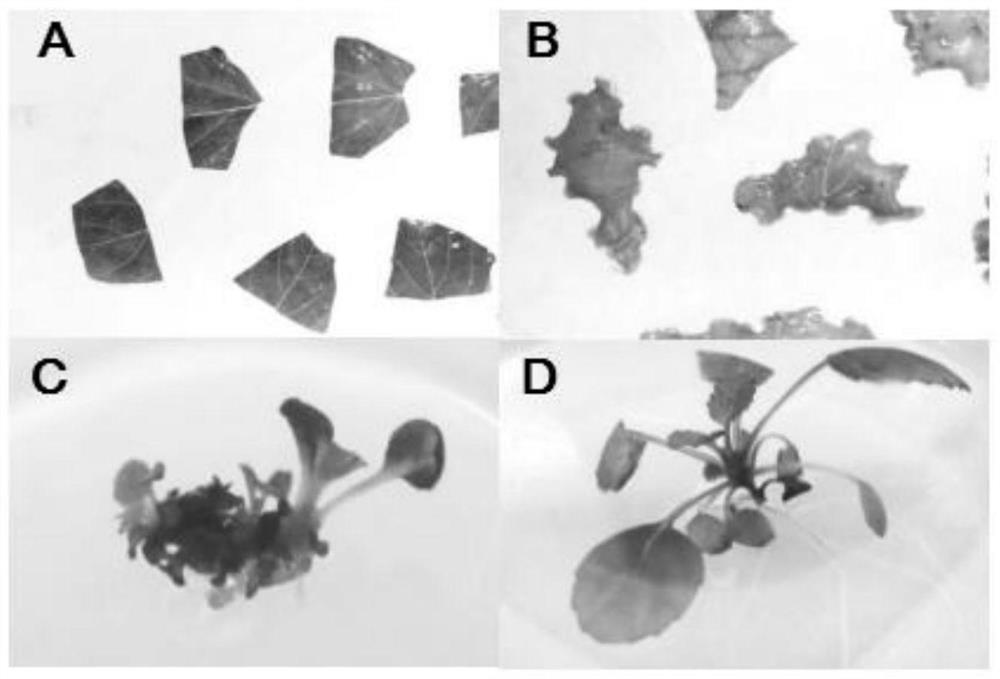Method for promoting salvia miltiorrhiza bunge lateral root development and increasing tanshinone content in salvia miltiorrhiza bunge root, salvia miltiorrhiza bunge gene sequence and overexpression vector
A technology of tanshinone content and overexpression vector, applied in the field of genetic engineering, can solve the problems of high cost of breed selection, complex structure of tanshinone, environmental pollution, etc., and achieve the effect of improving medicinal value
- Summary
- Abstract
- Description
- Claims
- Application Information
AI Technical Summary
Problems solved by technology
Method used
Image
Examples
Embodiment 1
[0027] Example 1: Amplification of the Danshen SmMYC2b gene sequence
[0028] The purpose of this embodiment is to obtain the gene fragment of the suspected transcription factor MYC2 from Salvia miltiorrhiza, and amplify it to obtain the amplified related gene fragment for transformation, including the following steps:
[0029] Step 1-1, extracting total RNA from Salvia miltiorrhiza, the operation method refers to the manual of TransZol UP PlusRNA Kit total RNA extraction reagent of TRANSGENE, including the following sub-steps:
[0030] Step 1-1-1, cut off the leaves of the aseptic salvia miltiorrhiza seedlings grown in the culture room for 10 weeks in an ultra-clean bench, and store them in liquid nitrogen;
[0031] Step 1-1-2, add liquid nitrogen to the leaf and quickly grind it into a fine powder, immediately divide the powder into eppendorf tubes with TRNzol-UP added in advance, use 1mL TRNzol-UP for every 50mg-100mg leaf;
[0032] Step 1-1-3, mix with a homogenizer, le...
Embodiment 2
[0072] Example 2: Construction of overexpression vector
[0073] The purpose of this example is to obtain the target gene from the Escherichia coli containing the target gene obtained in Example 1, and connect the target gene to the PHB-flag vector to construct an overexpression vector containing the target gene. Schematic diagram of the construction of the overexpression vector Such as figure 1 shown, including the following steps:
[0074] Step 2-1, designing primers and cloning the target fragment.
[0075] Among them, the principle of PCR primer design is: select the monoclonal restriction site contained on PHB-flag and the restriction site does not exist in the ORF region of the gene, and remove the stop codon of the target gene at the same time. The designed primer sequences are shown in Table 2-1 below. In Table 2-1, the parts in italics indicate restriction sites.
[0076] Table 2-1 Primers used for cloning target fragments
[0077]
[0078] The PCR reaction ...
Embodiment 3
[0093] Example 3: Construction of recombinant Agrobacterium
[0094] The purpose of this embodiment is to transfer the overexpression vector obtained in Example 2 into Agrobacterium to obtain recombinant Agrobacterium, including the following steps:
[0095] Step 3-1, prepare the required reagents, the formula of each reagent is as follows:
[0096] LB medium: 5g of yeast extract, 5g of sodium chloride, 10g of tryptone dissolved in 1L of deionized water, adjust the pH to 7; add 7.5g of plant agar powder per L of solid medium;
[0097] YEB medium: weigh yeast extract, sucrose, beef extract, peptone, MgSO 4 ·7H 2 O 0.983g, dissolved in 1000mL deionized water, adjust pH=7.2, if preparing solid medium, add 7g agar. Sterilize under high temperature and high pressure at 121°C for 20 minutes, and set aside.
[0098] B5 medium: B5 powder 3.21g, MgSO 4 ·7H 2 O 0.983g, plant agar powder 7.5g, sucrose 20g, high pressure steam sterilization, 121 ℃, 20min;
[0099] Kanamycin and h...
PUM
 Login to View More
Login to View More Abstract
Description
Claims
Application Information
 Login to View More
Login to View More - R&D
- Intellectual Property
- Life Sciences
- Materials
- Tech Scout
- Unparalleled Data Quality
- Higher Quality Content
- 60% Fewer Hallucinations
Browse by: Latest US Patents, China's latest patents, Technical Efficacy Thesaurus, Application Domain, Technology Topic, Popular Technical Reports.
© 2025 PatSnap. All rights reserved.Legal|Privacy policy|Modern Slavery Act Transparency Statement|Sitemap|About US| Contact US: help@patsnap.com



